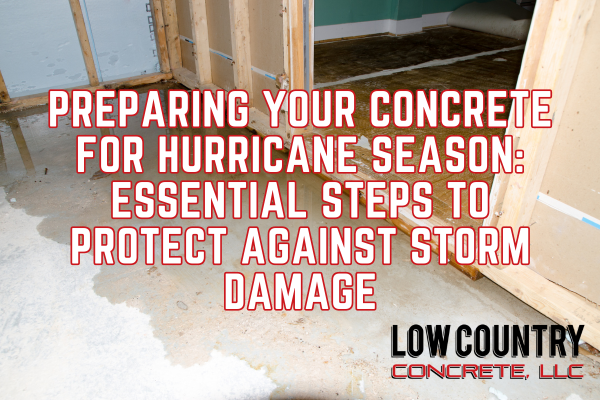As hurricane season heats up, it’s crucial for homeowners and property managers to prepare their properties to withstand potential storm damage.
Concrete, being a durable and versatile building material, can play a critical role in fortifying structures against the elements. However, proper preparation and maintenance are key to ensuring that concrete surfaces and structures remain resilient during hurricanes and severe weather events. Low Country Concrete, a trusted concrete contractor in South Georgia, is here to help you prepare. Here, we discuss essential steps to protect concrete against storm damage, covering both proactive measures and reactive strategies.
1. Inspecting and Repairing Existing Concrete
Before hurricane season begins, conduct a thorough inspection of all concrete surfaces and structures around your property. Look for signs of damage such as cracks, spalling (flaking or chipping), or uneven settling. Addressing these issues promptly is essential to prevent further deterioration during a storm. Here’s what you can do:
- Crack Repair: Use appropriate concrete patching products to fill and seal cracks. Small cracks can allow water to penetrate, leading to further damage and weakening of the structure.
- Spalling Repair: For areas where concrete has started to flake or chip, remove loose material and apply a suitable repair mortar or coating to restore the surface integrity.
- Leveling Uneven Surfaces: If you notice areas where concrete has settled unevenly, consider leveling the surface to prevent water pooling, which can weaken the concrete over time.
2. Applying Sealants and Waterproofing
One of the most effective ways to protect concrete surfaces from water damage is by applying high-quality sealants and waterproofing coatings. These products create a barrier that prevents water infiltration and protects the concrete from moisture-related deterioration. Here are some tips for applying sealants:
- Choose the Right Product: Select a sealant or waterproofing product that is suitable for the specific type of concrete surface (e.g., driveway, patio, foundation).
- Proper Application: Follow manufacturer instructions for application, ensuring thorough coverage and adequate drying time before exposure to rain or storms.
- Regular Maintenance: Inspect and reapply sealants as needed, typically every 1-3 years depending on weather conditions and wear.
3. Securing Outdoor Furniture and Objects
During hurricanes or strong storms, outdoor furniture, planters, and other objects can become projectiles that can cause significant damage to concrete surfaces and structures. Take these precautions:
- Anchor or Store Items: Secure outdoor furniture and objects by anchoring them to the ground or storing them indoors during storm warnings.
- Trim Trees and Branches: Prune trees and shrubs near concrete structures to reduce the risk of branches breaking off and causing damage during high winds.
4. Ensuring Proper Drainage
Poor drainage around concrete surfaces can lead to water pooling, which can weaken the soil beneath and compromise the stability of the concrete itself. Improve drainage by:
- Clearing Gutters and Downspouts: Keep gutters and downspouts free of debris to ensure water is directed away from concrete foundations and surfaces.
- Installing Drainage Systems: Consider installing French drains or other drainage solutions around concrete patios, driveways, and foundations to redirect excess water.
5. Emergency Preparedness
Despite thorough preparation, hurricanes can sometimes cause unforeseen damage. Prepare for emergencies by:
- Having a Plan: Develop an emergency plan that includes evacuation routes, emergency contacts, and procedures for securing your property.
- Stocking Supplies: Keep emergency supplies on hand, including plywood for covering windows, a generator, and basic tools for minor repairs.
6. Post-Storm Inspection and Maintenance
After a hurricane or severe storm passes, assess the condition of your concrete surfaces and structures:
- Inspect for Damage: Look for any signs of new cracks, shifts in structure, or water damage that may have occurred during the storm.
- Immediate Repairs: Address any new damage promptly to prevent further deterioration and ensure the structural integrity of your concrete.
The time to prepare your concrete for hurricane season is now.
Preparing concrete for hurricane season involves a combination of proactive maintenance and reactive strategies to mitigate potential storm damage. By inspecting, repairing, and fortifying concrete surfaces and structures, applying sealants and waterproofing, securing outdoor items, ensuring proper drainage, and preparing for emergencies, homeowners and property managers can significantly enhance the resilience of their properties against hurricanes and severe weather events. Contact Low Country Concrete for a quote today. Remember, timely action and regular maintenance are key to protecting your concrete investments and ensuring safety during hurricane season.


Recent Comments